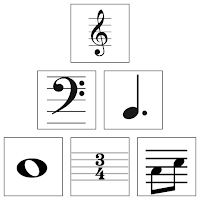Building Blocks: Building Major Scales I
This is the sixth lesson in the Building Blocks series. If you are just starting out I recommend you start here. So far we've learned about the musical alphabet and the difference between whole and half-steps and where they fall within the musical alphabet, and about the major scale pattern and how the C Major scale is derived from the musical alphabet using this pattern. We've learned about accidentals and how they affect notes, and we've also learned about the chromatic scale.
Since we now know about the chromatic scale and how sharps and flats affect notes, we have the tools to construct a major scale starting on any note we want. There are a couple of methods we can use to build major scales, and the first one is what I call the "additive method", in which we start with a note and add the whole and half-steps in order, one by one. Let's use this method to build an F Major scale:
Since major scales are named for their tonic note, the note we typically start the scale on, we know that the first note in the F Major scale is F:
F
Now we must recall the whole-step and half-step pattern for major scales: WWHWWWH, where W means "whole-step" and H means "half-step". Now something you may not have realized yet is that a half-step is the distance between any two consecutive notes in the chromatic scale, while a whole-step is the distance between every two notes in the chromatic scale. Check it out:
Now since we understand that, we can go back to our major scale pattern: WWHWWWH. The pattern starts with a whole-step, and since we are building an F Major scale we need to find the note that is a whole-step above F. Looking at the chromatic scale above we can see that the note G is one whole-step above F, because it is two chromatic notes away. So far for our F Major scale we have:
F G
That takes care of the first whole-step in the pattern, so now we need to find another whole-step, this time from G. Looking at the chromatic scale above we can see that the note A is one whole-step, or two chromatic notes above G. So now we have:
F G A
According to the pattern, the next note will be one half-step above A. Looking again at the chromatic scale above we can see that the note that is one half-step above A is the note A#, so we end up with:
F G A A#
Here we have a problem. If you recall from the previous lesson on the major scale, I mentioned that a major scale can only have one of each letter, but now we have two A's in our scale. What can we do about the A# so that we follow the rule of having only one of each letter in the scale? The answer has to do with that confusing concept we learned about: enharmonics. Remember when we learned about the keys on the piano keyboard that have more than one name? You'll recall that A# shares the same key on the piano as Bb, so in this case we must use the name "Bb" in order to follow the rule of "only one of each letter". Remember, spelling matters! Now that we fixed that, we have:
F G A Bb
Another rule for major scales is that there can be sharps or flats in a major scale, but not both! Since we already determined the F Major scale has a Bb, that means if there are any other accidentals, they will all be flats and there will be no sharps. Now that we know that, let's rewrite the chromatic scale with all flats, since we won't be using any sharp notes:
Going back to the scale pattern, the next note is going to be one whole-step above the Bb. Looking back at the chromatic scale above, we can see that the note C is one whole-step, or two chromatic notes, above Bb, so now we have:
F G A Bb C
The next step in the pattern is another whole-step. According to the chromatic scale, one whole-step above C is D, so we have:
F G A Bb C D
According to our pattern, WWHWWWH, the next step is another whole-step. One whole-step above D is E, so we get:
F G A Bb C D E
Now for the last step in the pattern, which is a half-step. One half-step above E is F, which is the note we started on, and the pattern starts over. Since the last half-step in the pattern gave us F, the note we started on, we know that we followed the pattern correctly. If we were to end on any note other than the note we started on, we would know we did something wrong and would have to start over to check our work.
That was quite a lot of work just to find one major scale, but it's extremely important that you understand how to do this because just about everything in music theory is based on how the major scale is constructed. There is another method to build a major scale which I will go over in the next lesson. Until then, let's recap:
- every major scale follows the step pattern of WWHWWWH
- any major scale can only have one and only one of each letter (except for the repeated tonic note at the top)
- a major scale may have sharps or flats, but not both
If you have questions put them in the comments below!


Comments
Post a Comment
Feel free to ask questions or start a discussion, or leave a suggestion for future articles! Please keep it civil.